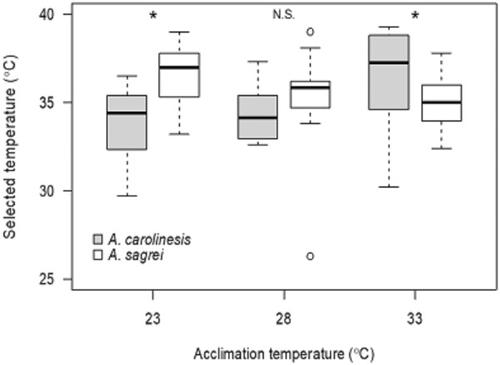当前位置:
X-MOL 学术
›
J. Exp. Zool. Part A
›
论文详情
Our official English website, www.x-mol.net, welcomes your feedback! (Note: you will need to create a separate account there.)
Competing native and invasive Anolis lizards exhibit thermal preference plasticity in opposite directions
Journal of Experimental Zoology Part A ( IF 2.8 ) Pub Date : 2020-10-13 , DOI: 10.1002/jez.2420 Lucy M Ryan 1 , Alex R Gunderson 1
Journal of Experimental Zoology Part A ( IF 2.8 ) Pub Date : 2020-10-13 , DOI: 10.1002/jez.2420 Lucy M Ryan 1 , Alex R Gunderson 1
Affiliation

|
Invasive species have emerged as a significant problem in the age of anthropogenic change. Behavior can be key to invasive species success and is strongly affected by temperature. Therefore, knowledge of the temperature dependence of behavior is likely critical to understand invasive species dynamics and their interactions with native species. In this study, we tested for differences in thermal preference plasticity and temperature‐dependent activity levels in a pair of congeneric lizards found in the United States: the invasive Anolis sagrei and the native A. carolinensis. We predicted that A. sagrei would demonstrate greater thermal preference plasticity and would utilize a higher and/or wider range of activity temperatures than A. carolinensis. Both would point to plasticity allowing A. sagrei to behaviorally exploiting thermal conditions that A. carolinensis cannot. We found that both species exhibited plasticity in thermal preference, but in opposite directions: preferred temperatures of A. carolinensis increased with acclimation temperature, while those of A. sagrei decreased. As a result, which species had a higher thermal preference changed with acclimation conditions. We saw no difference in overall field activity rates between the species, but that A. sagrei did tend to be active over a broader range of body temperatures. In sum, we found little evidence that differences in thermal preference plasticity between the species allow A. sagrei to remain active at a higher or broader temperature range than A. carolinensis. Nonetheless, the thermal preference data suggest complementary thermal preferences between the species that could promote microclimatic partitioning, though more work is required to test this idea.
中文翻译:

竞争的天然和侵入性Anolis蜥蜴在相反的方向上表现出热偏好可塑性
入侵物种已成为人为改变时代的一个重要问题。行为可能是入侵物种成功的关键,并且受到温度的强烈影响。因此,了解行为的温度依赖性对于了解入侵物种动态及其与本地物种的相互作用可能至关重要。在这项研究中,我们测试了一对同属蜥蜴在美国发现在热可塑性的偏好和依赖于温度的活动水平的差异:侵入安乐sagrei和本地A.蜥。我们预测,相比于卡罗莱纳州立曲霉,Agre Sagrei将表现出更大的热偏好可塑性,并利用更高和/或更宽的活性温度范围。。两者都指向可塑性,从而允许Agre Sagrei行为地利用A. carolinensis不能利用的热条件。我们发现,这两个物种表现出热可塑性的偏好,但在相反的方向:的优选温度A.蜥与驯化温度增加,而那些A. sagrei降低。结果,哪种物种具有更高的热偏好随驯化条件而变化。我们没有看到该物种之间的整体田间活动速率的差异,但是沙曲霉确实倾向于在更宽的体温范围内活跃。总之,我们发现几乎没有证据表明物种之间热偏好可塑性的差异允许A. sagrei在更高或更宽的温度范围内比保持活性A.蜥。尽管如此,热偏好数据表明,物种之间的互补热偏好可以促进微气候分区,尽管要检验这一想法还需要做更多的工作。
更新日期:2020-10-13
中文翻译:

竞争的天然和侵入性Anolis蜥蜴在相反的方向上表现出热偏好可塑性
入侵物种已成为人为改变时代的一个重要问题。行为可能是入侵物种成功的关键,并且受到温度的强烈影响。因此,了解行为的温度依赖性对于了解入侵物种动态及其与本地物种的相互作用可能至关重要。在这项研究中,我们测试了一对同属蜥蜴在美国发现在热可塑性的偏好和依赖于温度的活动水平的差异:侵入安乐sagrei和本地A.蜥。我们预测,相比于卡罗莱纳州立曲霉,Agre Sagrei将表现出更大的热偏好可塑性,并利用更高和/或更宽的活性温度范围。。两者都指向可塑性,从而允许Agre Sagrei行为地利用A. carolinensis不能利用的热条件。我们发现,这两个物种表现出热可塑性的偏好,但在相反的方向:的优选温度A.蜥与驯化温度增加,而那些A. sagrei降低。结果,哪种物种具有更高的热偏好随驯化条件而变化。我们没有看到该物种之间的整体田间活动速率的差异,但是沙曲霉确实倾向于在更宽的体温范围内活跃。总之,我们发现几乎没有证据表明物种之间热偏好可塑性的差异允许A. sagrei在更高或更宽的温度范围内比保持活性A.蜥。尽管如此,热偏好数据表明,物种之间的互补热偏好可以促进微气候分区,尽管要检验这一想法还需要做更多的工作。


























 京公网安备 11010802027423号
京公网安备 11010802027423号